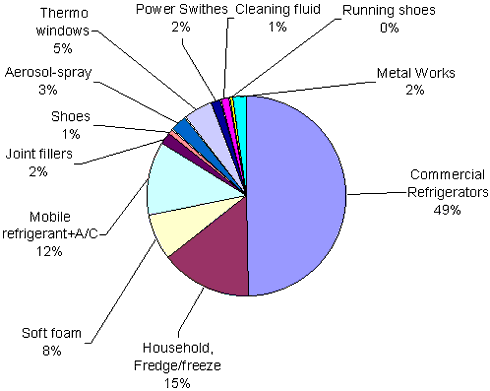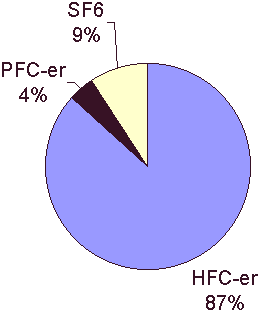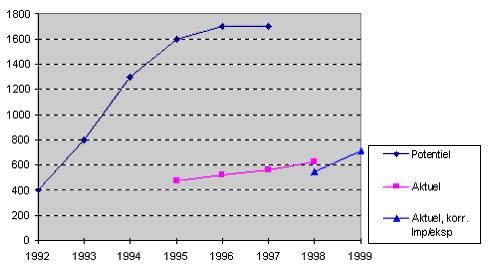Ozonlagsnedbrydende stoffer og visse drivhusgasser- 1999
2. Summary and conclusions
| 2.1 | Ozone depleting substances |
| 2.2 | Greenhouse gases |
| 2.2.1 | HFCs |
| 2.2.2 | Sulfur hexafluorid (SF6) |
| 2.2.3 | Perflourinated hydrocarbons |
| 2.2.4 | Development in the total GWP-weighted potential |
2.1 Ozone depleting substances
The ODP-weighted consumption in 1999 has been calculated to be approx. 85,3 ODP-tons which is a slight reduction of 16,2 ODP-tons compared to 1998.
Seen from the distribution of the ODP-weighted consumption in 1999 on various substances, the contribution is mostly from HCFC-14lb and HCFC-22.
The figure below shows the ODP-weighted consumption calculated on the basis of information on import from importers and manufacturers. The ODP-values are listed in Enclosure 6.1
Table 2.1
Overview of consumption and ODP-weighted consump-tion in 1999, tons.
Substances |
Gross |
ODP-weighted consumption, 1998 |
Gross consumption, 1999 |
ODP-weighted consumption, 1999 |
CFC-er (1) |
3,5 |
2,8 |
3,3 |
2,6 |
Tetrachlor- |
0,7 |
0,77 |
1,3 |
1,46 |
1,1,1-trichlo- |
< 0,2 |
< 0,02 |
< 0,03 |
< 0,003 |
Haloner |
0 |
0 |
0 |
0 |
Methylbromid |
0 |
0 |
0 |
0 |
HCFC-er HCFC-22 HCFC-141b HCFC-142b |
1172 534 621 17 |
98 29 68 1,1 |
1028,9 566 447,1 15,8 |
82,8 31,1 49,1 1 |
Total |
- |
101,5 |
- |
Ca. 85,3 |
(1) When calculating the ODP-weighted consumption of CFCs, only CFC-113 has been registered and used as basis of calculation.
The ODP-weighted consumption in Greenland has been calculated to 2,6 ODP-tons in 1999. In 1998 the level was 3,8 ODP-ton.
CFCs, tetrachlormethan and trichlorethan are used only for laboratory uses. HCFCs are used as refrigerant or for foaming. The range of application for HCFCs in 1999 are shown in Table 2.2.
Table 2.2
Distribution of the HCFC-consumption in range of application in 1999, tons
Application |
HCFC-22 |
HCFC-141b |
HCFC-142b |
Isolation foam (refrigerators, freezers etc.) |
20 |
447,1 |
15,8 |
Refrigerant |
546,1 |
0 |
0 |
Total |
566,1 |
447,1 |
15,8 |
HCFC 22 is primarily used as refrigerant and HCFC-141b and HCFC-142b is used only for foaming.
In figure 2.1 is shown the development of the ODP-weighted consumption.

Figure 2.1
Development of the ODP-weighted consumption.
2.2 Greenhouse gases
The GWP-weighted actual emission for HFCs, PFCs and SF6 for 1999 has been calculated to approx. 715.000 tons CO2-equivalents. Compared to the total Danish GWP-contribution, the emission of HFCs, PFCs and SF6 is below 1% of the total emission. The similar emission was approx. 540.000 ton CO2-equivalents in 1998. It corresponds to a total increasing 165.000 ton CO2-equivalents. The reason to increasing emissions is more emission from stock in general and a larger consumption of HFC-404a in commercial refrigerators.
In the following, table 2.3 is consumption, the actual emission and stock from products are summarized.
Table 2.3
Consumption, actual emission, installed substance, regulated for
import/export as well as GWP-emissions 1999, tons.
Application |
Substances |
Consumption |
Stock |
Actual emission |
GWP-weighted emission |
Commercial refrigirators |
HFC-134a HFC-404a HFC-401a HFC-402a HFC-407a HFC-507a Other HFC-er PFC All substances |
110,6 135,5 15 8 40 10 29
|
413 400 44 38 61 23 68
|
73 60 7 7 6 3 9
|
94.800 195.000 120 11.060 9.290 9.540 15.650
|
Fredge/freezes - Refrigerant - Isolating foam |
HFC-404a HFC-134a All substances |
24 241 |
50 1199 |
<1 70 |
2.450 92.000 105.990 |
Mobile A/C and |
HFC-134a HFC-404a HFC-402a All substances |
30 34 2 |
141 53 5 |
38 11 1 |
48.000 34.400 2.400 84.800 |
Shoe soles |
HFC-134a |
6 |
5,8 |
4,9 |
6.360 |
Soft foam |
HFC-134a HFC-152a All substances |
39 36 |
- - |
39 36 |
50.570 5.010 55.580 |
Joint fillers |
HFC-134a HFC-152a All substances |
- - |
- - |
10 0,5 |
13.000 70 13.070 |
Aerosol-spray |
HFC-134a |
14 |
- |
15 |
19.500 |
Cleaning fluid |
PFC |
- |
- |
1,5 |
10.500 |
Thermo Windows |
SF6 |
7,2 |
38,9 |
1,4 |
34.400 |
Power switches |
SF6 |
4,8 |
55,6 |
0,5 |
11.500 |
Running shoes |
SF6 |
0 |
0,5 |
0,1 |
2.650 |
Metal works |
SF6 |
0,7 |
- |
0,7 |
16.700 |
GWP-emission |
HFC's PFC's SF6 Total |
- - - |
- - - |
- - - |
620.760 29.800 65.250 715.810 |
In table 2.3 above, the total GWP-weighted emission from HFC's, PFC's and SF6 is shown in accordance to the particular applications.
In the following figure 2.2 is the total GWP-weighted emission from HFC's, PFC's and SF6 shown in connection to sources. It appears from the figure, which application provides the largest emissions in 1999.

Figure 2.2
GWP-contribution in % from HFCs, PFCs and SF6 distributed in sources.
As seen on the figure, the largest GWP-contribution is from emission of refrigerant from commercial stationary refrigerators. These plants represent 49% of the total actual contribution. The second largest GWP-contribution of 15% comes from isolation foam and refrigerant in connection with the fabri-cation of refrigerators and from evaporation from the installed number of refrigerators. 12% of the GWP-contribution derives from emission of refrigerant from mobile air-condition.
8% of the GWP-contribution derives from manufacturing of soft foam, 3% of the GWP-contribution derives from aerosol-spray, 2% from imported joint fillers and 1% derives from shoes
The primary source to SF6 emission in 1999 is from the production of thermo window glass with a contribution of 5% of the total contribution. The contribution from SF6-containing power switches at high-voltage plants and metalworks is 2%, which is nearly the same as the contribution from metal works (2%). The smallest contribution comes from disposal of running shoes with SF6. The contribution in 1999 was near by 0%.
The second largest contribution of 24% derives from the consumption of SF6 on metal works. The contribution from SF6-containing power switches at high-voltage plants is 22%, which is nearly the same as the contribution from metal works. This contribution arises from current emission at breakdowns etc. and at replenishment. The smallest contribution comes from disposal of running shoes with SF6. The contribution in 1998 was 8%.
HFCs contribute with 87% of the total GWP-weighted amount in 1999. The emission of SF6 contribute with 9% and the emission of PFCs contribute with 4% of the total emission. The relative distribution of actual emissions are shown in figure 2.3.

Figure 2.3
The relative distribution of the actual emission from HFCs, PFCs and SF6,
1999.
2.2.1 HFCs
The total use of HFCs are approx. 978,3 tons in 1999 which shows a decrease of 22% compared to 1998. The consumption of HFC-404a has increased, whereas the consumption of HFC-134a has decreased in 1999. The con-sumption of other HFCs, including HFC-407c and HFC-507a has slightly gone up.
The total GWP-consumption from HFCs is approx. 620.000 tons CO2-equivalents. It is a increase of approx. 36% compared to the 1998 contribu-tion.
2.2.2.
Sulfur hexafluorid (SF6)The consumption of SF6 was 12,1 tons in 1999, which is a moderate increase compared to 1998, whereas the consumption was 9 tons. The increased consumption is due to an increase in the use of SF 6 in power switches. It should be noticed, that the installation of one GIS-plant represented 3 tons and that such large installations are quite rare. The 3 tons are approximately equivalent to the increase in consumption from 1998 to 1999.
The actual emission has been calculated to be 2,7 tons, equivalent to a GWP-contribution of 65,250 tons CO2 -equivalents. There is a slight fall compared to 1998, where the contribution was 69,300 tons CO2-equivalents.
2.2.3 Perflourinated hydrocarbons
The only perflourinated hydrocarbon, used in Denmark is perfluorpropane. Perfluorpropane is used in a composite product for cooling purposes in an amount of approx. 6,4 tons in 1999. The emission was 2,8 tons, which comes partly from filling of refrigerant and partly from loss from installed amounts. Furthermore, 1,5 ton perfluorpropane is used in cleaning fluid for electronic components .
The actual GWP-weighted emission was 29.500 tons CO2-equivalents in 1999, which has been increased considerably compared to 1998 with 17.500 tons CO2-equivalents . There has been a slight increase in the emission from commercial refrigerators. A part from that, a new source has been identified (cleaning fluids) which was not included in previous years' statements.

Figure 2.4
The development of the GWP-weighted potential, actual and new actual emission
1992-1999, 1000 tons CO2-eq.
The calculation of actual emission depends on the calculation method and the data basis of the application areas and products with HFCs, PFCs and SF6. The data basis will be improved as reporting from manufacturers and importers are extended.
Figure 2.4 shows a boil down of consumption and actual emission as well as the installed amount of substances in the product, after adjustment of any import and export of substances in the products. For comparative reasons, emissions are also calculated according to the ‘old’ calculation method. These emissions are shown in brackets.
2.2.4 Development in the total GWP-weighted potential
Figure 2.4 shows the development in the Danish CWP-contribution 1992-1999 from HFC's, PFC's and SF6I .The relative difference of the calculation of the total GWP-value seen from the present and earlier calculation methods, is seen in the figure figure.
The development in the GWP-contribution 1992-1999 can also be seen in table 2.4 below. The total GWP-contribution has been calculated after 3 different calculation methods used during this period.
Tabel 2.4
Total GWP-contribution from HFC, PFC, SF6 1000 tons CO2 -eq.
|
Potential |
Actual |
Actual, corre. Imp/eksp |
1992 |
400 |
|
|
1993 |
800 |
|
|
1994 |
1300 |
|
|
1995 |
1600 |
480 |
|
1996 |
1700 |
520 |
|
1997 |
1700 |
560 |
|
1998 |
|
625 |
542,5 |
1999 |
|
|
715,2 |